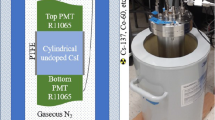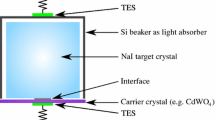Abstract
The light yield of scintillating crystals which is quantified by light Quenching Factors (QFs) strongly depends on the kind of interaction in the crystal. For Dark Matter experiments like CRESST the precise knowledge of QFs is crucial for the discrimination of background events from possible WIMP signals. At the tandem accelerator of the Maier-Leibnitz-Laboratorium (MLL) in Garching a low-temperature scattering facility was set up, which in its current phase aims at the determination of the QFs of O, Ca, and W in CaWO4 crystals as used in the CRESST experiment. A CRESST detector module consists of a 300 g CaWO4 target crystal operated as a phonon detector and a separate silicon-on-sapphire (SOS) light detector to detect the corresponding scintillation light simultaneously. In order to disentangle the light yield corresponding to O, Ca and W recoils, monoenergetic neutrons (11 MeV) produced by the accelerator are scattered off an especially developed CRESST-like detector module, which is operated at mK temperatures in a dilution refrigerator. Arrays of liquid-scintillator detectors placed at fixed scattering angles allow one to identify the recoiling nuclei by a neutron time-of-flight measurement. The unique facility is suited for the characterization of different detector materials and will be a powerful tool also for the future multi-material experiment EURECA. We report on the experimental approach, the low-temperature setup and present first results.




Similar content being viewed by others
References
G. Angloher et al., Astropart. Phys. 31, 270 (2009)
M. Drosg, Nucl. Instrum. Methods A 254, 466 (1987)
J.-C. Lanfranchi et al., Opt. Mater. 31, 1405 (2009)
R. Strauss, PhD thesis, Physik-Department E15, TU München, in preparation
C. Ciemniak, PhD thesis, Physik-Department E15, TU München (2011)
H. Kraus et al., Nucl. Phys. B, Proc. Suppl. 173, 168 (2007)
C. Isaila et al., arXiv:1106.0167 [physics.ins-det]
C. Isaila, PhD thesis, Physik-Department E15, TU München (2010)
M. v. Sivers, Diploma thesis, Physik-Department E15, TU München (2010)
Acknowledgements
This work was supported by funds of the Deutsche Forschungsgemeinschaft DFG (Transregio 27: Neutrinos and Beyond), the Munich Cluster of Excellence (Origin and Structure of the Universe), the Maier-Leibnitz-Laboratorium (Garching). We would like to thank Walter Carli and his team at the MLL tandem accelerator for the constant support.
Author information
Authors and Affiliations
Corresponding author
Rights and permissions
About this article
Cite this article
Strauss, R., Ciemniak, C., Deuter, G. et al. Neutron Scattering Facility for the Measurement of Light Quenching Factors of Dark Matter Detectors at Low Temperatures. J Low Temp Phys 167, 1063–1068 (2012). https://doi.org/10.1007/s10909-012-0536-4
Received:
Accepted:
Published:
Issue Date:
DOI: https://doi.org/10.1007/s10909-012-0536-4




